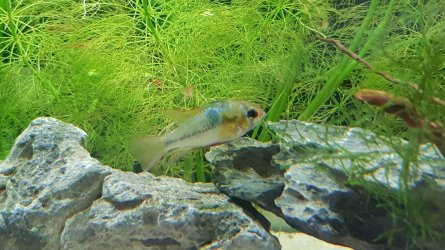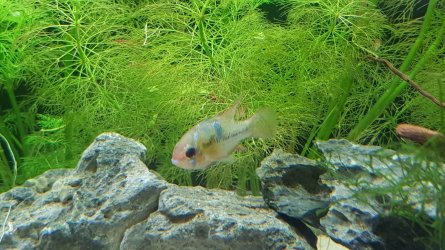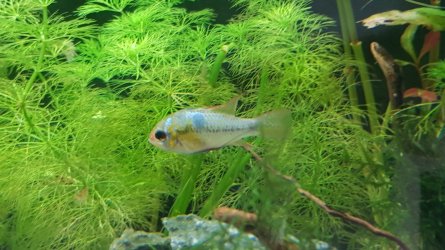I've noticed my German Blue Ram has looked a bit dull lately. He is still eating but colors are nowhere near as vibrant as they used to be. Haven't noticed if his poo is white or anything but his stomach does look a little deflated. Is he deteriorating?
🌟 Exclusive Amazon Black Friday Deals 2024 🌟
Don’t miss out on the best deals of the season! Shop now 🎁
You are using an out of date browser. It may not display this or other websites correctly.
You should upgrade or use an alternative browser.
You should upgrade or use an alternative browser.
GBR color fading
- Thread starter Mick85
- Start date
27°CPicture, tank temp, tankmates, water hardness.
Anything added of late?
Tank mates are honey gourami, BNPs, corys, harlequin rasboras, red eye tetras and kuhli loaches.
Kh and Gh is around 50-100ppm
Last thing that was added was 8 panda corys but that was about a month ago and he was fine up until a few days ago.
There could be some excess slime on the GBR or the fish may have voluntarily faded its colours in response to aggression from other fish. Corydoras are completely placid so will not be the source of the stress.
The black horizontal mark across its body is a typical sign something is stressing it out.
Try and rearrange your plants in such a way that it has its own hiding space to reduce stress. If you do this I would recommend putting the GBR in a temporary container while you do this as it will not tolerate any released toxins caused by agitating the substrate through moving plants. Follow any rearrangement with a 80% water change.
The black horizontal mark across its body is a typical sign something is stressing it out.
Try and rearrange your plants in such a way that it has its own hiding space to reduce stress. If you do this I would recommend putting the GBR in a temporary container while you do this as it will not tolerate any released toxins caused by agitating the substrate through moving plants. Follow any rearrangement with a 80% water change.
The GBR is the most aggressive fish i have in the tank lol he's the one who chases the little fat balloon tetras and corys around. Also the tank has heaps of plants so line of sight can be broken very easily if he wanted to hide.There could be some excess slime on the GBR or the fish may have voluntarily faded its colours in response to aggression from other fish. Corydoras are completely placid so will not be the source of the stress.
The black horizontal mark across its body is a typical sign something is stressing it out.
Try and rearrange your plants in such a way that it has its own hiding space to reduce stress. If you do this I would recommend putting the GBR in a temporary container while you do this as it will not tolerate any released toxins caused by agitating the substrate through moving plants. Follow any rearrangement with a 80% water change.
Something is probably fighting back or it is aware of something somewhere that is making it stressed. The black horizontal line shown on the GBR in your picture is evidence for this.The GBR is the most aggressive fish i have in the tank lol he's the one who chases the little fat balloon tetras and corys around. Also the tank has heaps of plants so line of sight can be broken very easily if he wanted to hide.
Is the fish's muscle tissue in the body looking cream/ white more now than usual?
It looks a bit white to me and that could indicate a microsporidian infection. However. the fish might always look like that, in which case it's not a microsporidian infection.
--------------------
Wipe the inside of the glass down with a clean fish sponge.
Do a 75% water change and gravel clean the substrate every day for a week. The water changes and gravel cleaning will reduce the number of disease organisms in the water and provide a cleaner environment for the fish to recover in.
Make sure any new water is free of chlorine/ chloramine before it is added to the tank.
Clean the filter if it hasn't been done in the last 2 weeks. However, if the filter is less than 6 weeks old, do not clean it. Wash the filter materials/ media in a bucket of tank water and re-use them. Tip the bucket of dirty water on the garden/ lawn. Cleaning the filter means less gunk and cleaner water with fewer pathogens.
Increase surface turbulence/ aeration when using salt or medications because they reduce the dissolved oxygen in the water.
Maybe add some salt, (see directions below). If it's microsporidian, use 2 heaped tablespoons of salt for every 20 litres of water. Keep the salt in the tank for a month.
--------------------
SALT
You can add rock salt (often sold as aquarium salt), sea salt or swimming pool salt to the aquarium at the dose rate of 1 heaped tablespoon per 20 litres of water. If there is no improvement after 48 hours you can double that dose rate so there is 2 heaped tablespoons of salt per 20 litres.
If you only have livebearers (guppies, platies, swordtails, mollies), goldfish or rainbowfish in the tank you can double that dose rate, so you would add 2 heaped tablespoons per 20 litres and if there is no improvement after 48 hours, then increase it so there is a total of 4 heaped tablespoons of salt per 20 litres.
Keep the salt level like this for at least 2 weeks but no longer than 4 weeks otherwise kidney damage can occur. Kidney damage is more likely to occur in fish from soft water (tetras, Corydoras, angelfish, Bettas & gouramis, loaches) that are exposed to high levels of salt for an extended period of time, and is not an issue with livebearers, rainbowfish or other salt tolerant species.
The salt will not affect the beneficial filter bacteria but the higher dose rate (4 heaped tablespoons per 20 litres) will affect some plants and some snails. The lower dose rate (1-2 heaped tablespoons per 20 litres) will not affect fish, plants, shrimp or snails.
After you use salt and the fish have recovered, you do a 10% water change each day for a week using only fresh water that has been dechlorinated. Then do a 20% water change each day for a week. Then you can do bigger water changes after that. This dilutes the salt out of the tank slowly so it doesn't harm the fish.
If you do water changes while using salt, you need to treat the new water with salt before adding it to the tank. This will keep the salt level stable in the tank and minimise stress on the fish.
It looks a bit white to me and that could indicate a microsporidian infection. However. the fish might always look like that, in which case it's not a microsporidian infection.
--------------------
Wipe the inside of the glass down with a clean fish sponge.
Do a 75% water change and gravel clean the substrate every day for a week. The water changes and gravel cleaning will reduce the number of disease organisms in the water and provide a cleaner environment for the fish to recover in.
Make sure any new water is free of chlorine/ chloramine before it is added to the tank.
Clean the filter if it hasn't been done in the last 2 weeks. However, if the filter is less than 6 weeks old, do not clean it. Wash the filter materials/ media in a bucket of tank water and re-use them. Tip the bucket of dirty water on the garden/ lawn. Cleaning the filter means less gunk and cleaner water with fewer pathogens.
Increase surface turbulence/ aeration when using salt or medications because they reduce the dissolved oxygen in the water.
Maybe add some salt, (see directions below). If it's microsporidian, use 2 heaped tablespoons of salt for every 20 litres of water. Keep the salt in the tank for a month.
--------------------
SALT
You can add rock salt (often sold as aquarium salt), sea salt or swimming pool salt to the aquarium at the dose rate of 1 heaped tablespoon per 20 litres of water. If there is no improvement after 48 hours you can double that dose rate so there is 2 heaped tablespoons of salt per 20 litres.
If you only have livebearers (guppies, platies, swordtails, mollies), goldfish or rainbowfish in the tank you can double that dose rate, so you would add 2 heaped tablespoons per 20 litres and if there is no improvement after 48 hours, then increase it so there is a total of 4 heaped tablespoons of salt per 20 litres.
Keep the salt level like this for at least 2 weeks but no longer than 4 weeks otherwise kidney damage can occur. Kidney damage is more likely to occur in fish from soft water (tetras, Corydoras, angelfish, Bettas & gouramis, loaches) that are exposed to high levels of salt for an extended period of time, and is not an issue with livebearers, rainbowfish or other salt tolerant species.
The salt will not affect the beneficial filter bacteria but the higher dose rate (4 heaped tablespoons per 20 litres) will affect some plants and some snails. The lower dose rate (1-2 heaped tablespoons per 20 litres) will not affect fish, plants, shrimp or snails.
After you use salt and the fish have recovered, you do a 10% water change each day for a week using only fresh water that has been dechlorinated. Then do a 20% water change each day for a week. Then you can do bigger water changes after that. This dilutes the salt out of the tank slowly so it doesn't harm the fish.
If you do water changes while using salt, you need to treat the new water with salt before adding it to the tank. This will keep the salt level stable in the tank and minimise stress on the fish.
Similar threads
- Replies
- 4
- Views
- 750
- Replies
- 11
- Views
- 564
- Replies
- 20
- Views
- 762




